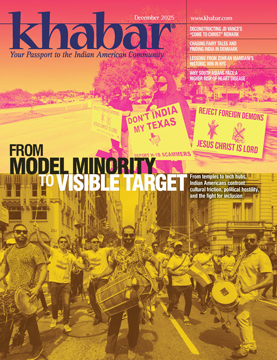Teen Talk: Am I Indian Enough?

The confessions of an “ABCD” on her cultural identity.
Growing up, my family sometimes teased me by calling me an ABCD: American-Born Confused Desi. While it was certainly meant to be a term of endearment by them, it never really felt that way to me. Being a classic overachieving Brown kid, I hated the very notion of being confused. I felt like I always knew “the answer.” And that if I didn’t, I could look it up in a book or an online search.
I never thought that what would finally “confuse” me would be my cultural identity. As an Indian American, I felt there was a list of prerequisites to be accepted as truly Indian—as if I had to build my “Indian” resume.
By this definition, I had definitely failed the test. For one, my Hindi was spotty. Despite being born American, I had spent a year of my childhood in India and even attended school there. Yet, after moving back to the U.S., my Hindi quickly morphed into its own breed. Pretty soon, my “theek-hai” turned into “tick-ai”, and my “Diwali” turned into “duh-wally.” Every phone call to India now consisted of the same phrases, the ones I had studied and perfected: aap kaise ho (how are you), school achha chal raha hai (school is going well), main bahut jaldi India aa rahi hoon (I am coming to India soon!).
It’s not to say Hindi wasn’t a part of my daily life. No, I heard it in the songs my dad played in the car—or (at impressive decibels!) from my mom when I forgot to clean my room. But, despite perfectly understanding the language, I very rarely dared to actually speak it. I felt my American accent would reveal to everyone that I was an imposter. And because I never actually spoke Hindi much, the cycle only continued.
The thought that people would find out I was not a “real Indian” hounded me all the time. These thoughts were crowding me when I quit my Hindi classes. And even more when I quit kathak. And they fully consumed me when I stopped learning Indian classical singing.
As I watched my friends write Hindi or perform at their arangetrams, I couldn’t help but feel less than them. If I were really Indian, wouldn’t I have enjoyed Kathak? Wouldn’t I have kept singing? Such feelings intensified when I saw desi girls my age proudly posting photos from garba nights or of the lehengas they wore to birthday parties. And when I watched TikToks of teen-agers dancing to Bollywood songs or mouthing Arijit Singh songs perfectly. Comparing myself to them made me feel less Indian.
Worse, I felt I was too far along to ever catch up on my Indian identity. “If only” and “I wish” dictated my life, and I always felt guilty for not trying hard enough. I saw India everywhere while growing up, so the fact that I was too whitewashed had to be my fault. I truly didn’t think I was Indian enough. At every Diwali celebration or pooja, I held my breath, waiting for somebody to point fingers and say I did not belong.
 Turns out, you cannot take the Indian out of me
Turns out, you cannot take the Indian out of me
And yet, I will always pick Indian food over Chipotle, McDonalds, and even Taco Bell. At any restaurant, when the waiter asks, “What spice level do you want?” the answer is always “the highest.” And then, when the waiter follows it up with, “Are you really sure?” I say, “Yes, I’m really sure.” When I fear I will never find love and have my weekly teen life crisis, my first instinct is to watch Yeh Jawaani Hai Deewani. Yes, my childhood consisted of Sofia the First and Curious George, but it was also made up of Doremon and Chhota Bheem. I loved Marvel, but the first comic books I remember reading were Amar Chitra Katha and Panchatantra.
As I have grown older, I have begun to realize India is still in my blood. It’s there when I mispronounce words like Wednesday. It’s there when I unconsciously stick a “na” or a “hain” at the end of my sentence. And it’s certainly there when I sprinkle a mound of chili flakes on my pasta at an Italian restaurant.
More importantly, I realize that our identity does not manifest only in our dialogue or at grand parties and events. Instead, it's also found in the quiet parts of our lives when we think nobody else is watching. Seen from that lens, India has been and will always be a part of my identity.
Take it from me! I’ve been searching for the appropriate and conventional Indian American identity in every story I’ve told and every column I’ve written. I've been searching for the answer that will make me fit into some narrative. But there is no single answer, and there never will be. While that may sound pessimistic, I truly believe it’s not. The reason there is no solution is because everyone's narrative is different. Everyone has a unique story to tell, and truly, what could be more beautiful than that? It’s precisely this vast tapestry of stories and experiences that makes it impossible to define a single core of the Indian American identity. Instead, we must create our own definition that remains true to us and not anyone else. It doesn’t matter if we grew up here; our experiences, by default, are Indian enough. We do not have to prove or work toward anything.
We all search for clarity, regardless of whether we’re Indian, American, or Indian American. Even as I continue to discover and evolve my identity, I realize I will always be an ABCD—a little bit confused. And guess what? That’s just fine with me. Because my Indianness, even in all its so-called imperfection, is a deeply integral part of me that no one, including me, can deny. And so, I can’t wait to get back to making 50 grammatical errors when speaking Hindi!
Column host Gia Agarwal is a 10th-grader who, when not crushing it in her advanced writing classes, is out there living every book lover's dream. She can be reached at TeenTalk@Khabar.com.
Enjoyed reading Khabar magazine? Subscribe to Khabar and get a full digital copy of this Indian-American community magazine.
blog comments powered by Disqus










